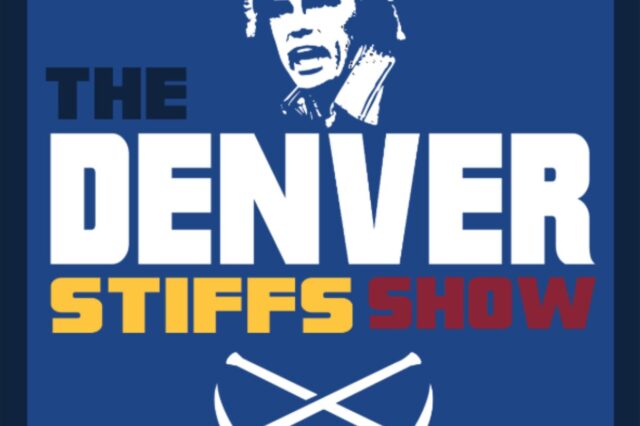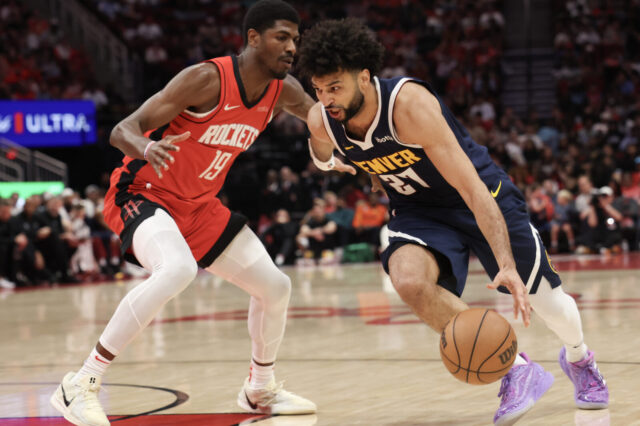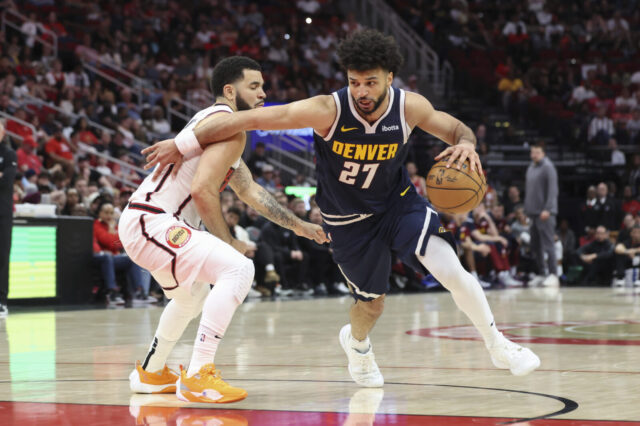The small forward defensive stud seemed to come out of nowhere. After going undrafted and bouncing around Europe for five year, he finally caught a break in that fifth season, a chance to play for the Miami Heat. He was so impressive (koff) in the contest that it was the only game he played for the Heat all season. He’d not see the floor again until he caught on the following year with the Boston Celtics. He’d then see time with Philadelphia and another stint with the Heat before truly catching fire with the team that ended up retiring his number after eight All-Defensive selections. You never know what surprises may come from out of the undrafted blue, including a sterling stud like the San Antonio Spurs’ Bruce Bowen.
Torrey Craig is not Bruce Bowen. Not yet, anyway. The beginnings are strikingly similar, though. The comparison below is Bowen’s third year in the league, at the same age as Craig.
This content is no longer available.
Bowen shows as a far stronger defender in his third year, but Craig compares pretty favorably in many other categories. Bowen was an outlier amongst so many similar beginnings for NBA players, but the tenacity of their paths to the league and defensive pedigrees gave rise to the comparison. Craig may never catch Bowen as a defender, as Bruce was an all-timer. But Craig definitely improved the defensive presence of the Denver Nuggets, as coach Michael Malone was touting him as the team’s best defender in the preseason, long before Craig actually got to spend any time on court. In the 39 games he did get to play with the team, he was primarily tasked with hounding the opposition’s best guard or wing on the court. Here’s Craig’s first season with the Nuggets, in review:
Overview
Craig started the year terrorizing the G-League before bumping up to join the big club on December 15th. Malone wasn’t shy about breaking the 27-year old rookie in, giving him 18 and a half minutes in his first game. Craig put up six points, four rebounds, two assists, and two blocks in a win against the Pelicans that night, en route to season averages of 4.2 points and 3.3 rebounds per game, as seen in the lines above.
Speaking of that shiny G-League showing, Craig’s 15 games with the Sioux Falls Skyforce looked a little more like this:
This content is no longer available.
Game averages of 34.9 minutes per game in the G-League netted Torrey 22.9 points, 8.1 boards, two blocks, and 3.4 assists per game on 48% shooting from the field and 39% from beyond the arc. Imagine that type of output from the small forward position for the Nuggets someday.
Key Stat
Rebounds: Torrey gobbled up boards at a higher rate than any other small forward on the team, adding to his value as a defender and grinder. Craig’s 7.3 boards per 36 minutes ranks him as the sixth-best on the team with only Kenneth Faried, Nikola Jokic, Mason Plumlee, Trey Lyles, and Paul Millsap ahead of him. Adding all of Torrey’s small contributions together ensure the Nuggets have more possessions per game.
Best moment
There were a number to choose from, but Torrey didn’t take long to make an impression in that first game against the Pelicans, blocking a Jrue Holiday shot at the end of regulation that sent the game into an overtime victory for the Nuggets at home. Not bad, newbie…
Areas of strength
It’s a terrible analogy, but my dad used to admire a Denver Broncos Orange Crush safety named Steve Foley. The reason pop used to look up to Foley was a knack for always being in the right place at the right time.
Craig has a very similar knack with the Nuggets, and that fuels a lot of what makes him a good defensive player, but it also serves his offense. Locking up the opposition on defense, and jumping right into the cutting-and-motion style that fuels the best version of the Nuggets offense stem from his innate ability to be in the right place from moment to moment. It also helps him get to where the ball is going to be to fuel that rebounding rate.
He also protects the ball well, tied with Richard Jefferson for the second-lowest per-36 turnover rate (1.1) amongst the team.
Areas to improve
Scoring: Torrey is on the court to provide a defensive presence, but if he could bring the amount of offense to the floor that he was able to in the G-League, he could cement himself as one of the team’s most important pieces. His per-36 scoring average of 9.6 makes him second-worst on the team, and he’s shown the ability to do more. Look for that to be a place for Craig to step forward next year, when he (hopefully) returns to Denver.
Steals: Craig could learn a lot from teammate Gary Harris in the steals department, as he only nabs 0.7 per-36, tied with fellow small forward Wilson Chandler for second-worst on the team.
Expectations for next year
First off, let’s just hope there is a next year. Craig was on a two-way deal with Denver this last year, and proved his value (literally) time and again on the court. Fellow Stiff Adam Mares sung the praises of Craig earlier in the year, saying, “every team needs a player like Torrey Craig.” For Denver to have unearthed a player who looks to be able to be another key contributor is a boon for the team, so here’s to hoping they find a way to get him onto the squad.
With that, Craig could only benefit from an offseason assured that he’s got something solid to be working towards as he’s now got nearly a half-season of the very best competition in front of him, and he’s shown he can not only bear the pressure, but shine because of it. Whoever Torrey Craig is playing for next season should expect to see a big step forward as he will have had the time to adjust to the pro game even further. The next two to three seasons for Craig will be interesting to watch, as he enters the league a few years later than many rookies, but having shown he belongs.


